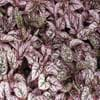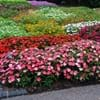Life Span
Perennial
Perennial
Type
Tender Perennial
Perennial
Origin
Latin America and the Caribbean
Eastern Europe
Types
Not Available
Not Available
Habitat
Humid climates, Warmer regions
Terrestrial
USDA Hardiness Zone
10-15
4-9
Sunset Zone
H1, H2, 24
1a, 1b, 2a, 2b, 3a, 3b, 4, 5, 6, 7, 8, 9, 10, 11, 12, 13, 14, 15, 16, 17, 18, 19, 20, 21, 22, 23, 24
Habit
Thicket/Colonizing
Clump-Forming
Flower Color
White, Yellow, Red, Green, Orange, Orange Red
Yellow, Lavender, Blue Violet
Flower Color Modifier
Bicolor
Bicolor
Fruit Color
Red, Orange
Not Available
Leaf Color in Spring
Green
Green, Sea Green
Leaf Color in Summer
Green, Dark Green
Green, Sea Green
Leaf Color in Fall
Dark Green
Green, Sea Green
Leaf Color in Winter
Light Green
Light Green
Leaf Shape
Ovate
Lanceolate
Plant Season
Spring, Summer, Fall, Winter
Spring, Summer
Sunlight
Full Sun, Partial Sun, Partial shade
Full Sun, Partial Sun
Growth Rate
Very Fast
Medium
Type of Soil
Loam, Sand
Loam, Sand
The pH of Soil
Acidic, Neutral, Alkaline
Neutral
Soil Drainage
Average
Well drained
Bloom Time
Indeterminate
Spring, Late Spring, Early Summer
Tolerances
Drought
Drought
Where to Plant?
Container, Ground, Pot
Ground
How to Plant?
From Rhizomes, Micropropagation
By dividing rhizomes, tubers, Seedlings
Plant Maintenance
Low
Medium
Watering Requirements
Average Water Needs
Average Water Needs, Do Not over Water
In Summer
Lots of watering
Lots of watering
In Spring
Moderate
Moderate
In Winter
Average Water
Average Water
Soil pH
Acidic, Neutral, Alkaline
Neutral
Soil Type
Loam, Sand
Loam, Sand
Soil Drainage Capacity
Average
Well drained
Sun Exposure
Full Sun, Partial Sun, Partial shade
Full Sun, Partial Sun
Pruning
Cut or pinch the stems, Remove damaged leaves, Remove dead branches, Remove dead leaves
Remove damaged leaves, Remove dead branches, Remove dead leaves
Fertilizers
Fertilize every two months
All-Purpose Liquid Fertilizer
Pests and Diseases
Mealybugs, Nematodes, Red blotch, Soft scales
Red blotch
Plant Tolerance
Salt
Drought
Flower Petal Number
Not Available
Single
Foliage Texture
Coarse
Coarse
Foliage Sheen
Glossy
Matte
Attracts
Hummingbirds, Insects
Hummingbirds
Allergy
Toxic
Skin irritation
Aesthetic Uses
Beautification, Cottage Garden
Showy Purposes
Beauty Benefits
Not Available
Not Available
Environmental Uses
Food for birds
Air purification
Medicinal Uses
Healing
No Medicinal Use
Part of Plant Used
Root, Seeds
Not Available
Other Uses
Florist trade and landscaping
Used as Ornamental plant
Used As Indoor Plant
No
No
Used As Outdoor Plant
Yes
Yes
Garden Design
Bedding Plant, Container, Cutflower, Feature Plant, Groundcover, Mixed Border, Tropical
Alpine, Edging, Mixed Border, Rock Garden, Wall
Botanical Name
HELICONIA psittacorum 'Lady Di'
IRIS pumila
Common Name
Heliconia, Lady Di Heliconia, Parakeet Flower
Dwarf Iris
In Hindi
Heliconia
Dwarf Iris
In German
Heliconia
Zwergiris
In French
Heliconia
Dwarf Iris
In Spanish
Heliconia
Enano Iris
In Greek
Heliconia
νάνος Ίρις
In Portuguese
Heliconia
Dwarf Iris
In Polish
Heliconia
Dwarf Iris
In Latin
Heliconia
Iris Dwarf
Phylum
Magnoliophyta
Magnoliophyta
Class
Liliopsida
Liliopsida
Order
Zingiberales
Liliales
Family
Heliconiaceae
Iridaceae
Clade
Angiosperms, Commelinids, Monocots
Angiosperms, Monocots
Tribe
Not Available
Irideae
Subfamily
Not Available
Iridoideae
Number of Species
Not Available
Importance of Heliconia and Dwarf Iris
Want to have the most appropriate plant for your garden? You might want to know the importance of Heliconia and Dwarf Iris. Basically, these two plants vary in many aspects. Compare Heliconia and Dwarf Iris as they differ in many characteristics such as their life, care, benefits, facts, etc. Every gardener must at least have the slightest clue about the plants he wants to plant in his garden. Compare their benefits, which differ in many ways like facts and uses. The medicinal use of Heliconia is Healing whereas of Dwarf Iris is No Medicinal Use. Heliconia has beauty benefits as follows: Not Available while Dwarf Iris has beauty benefits as follows: Not Available.
Compare Facts of Heliconia vs Dwarf Iris
How to choose the best garden plant for your garden depending upon its facts? Here garden plant comparison will help you to solve this query. Compare the facts of Heliconia vs Dwarf Iris and know which one to choose. As garden plants have benefits and other uses, allergy is also a major drawback of plants for some people. Allergic reactions of Heliconia are Toxic whereas of Dwarf Iris have Skin irritation respectively. Having a fruit bearing plant in your garden can be a plus point of your garden. Heliconia has showy fruits and Dwarf Iris has no showy fruits. Also Heliconia is not flowering and Dwarf Iris is flowering. You can compare Heliconia and Dwarf Iris facts and facts of other plants too.



